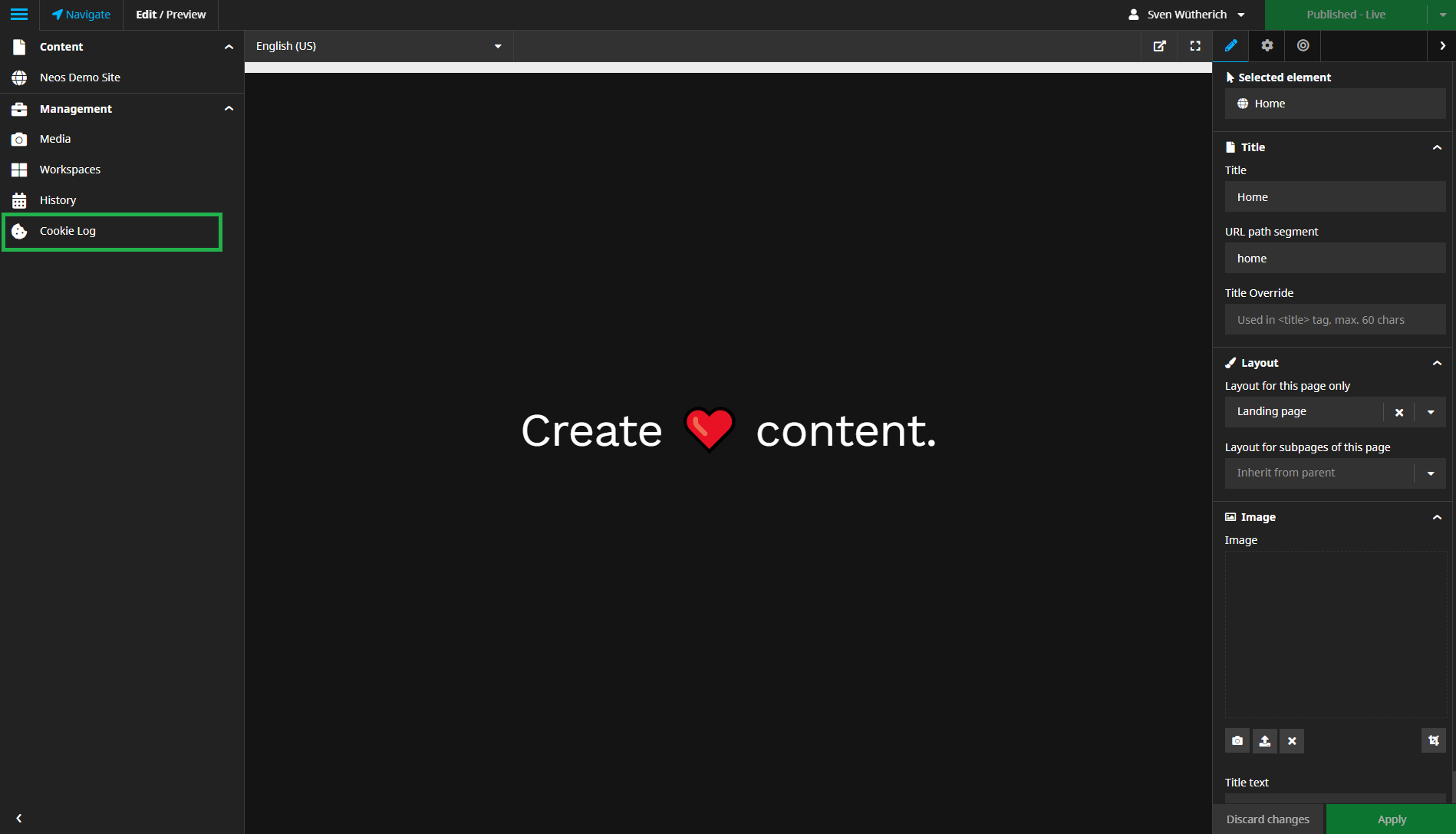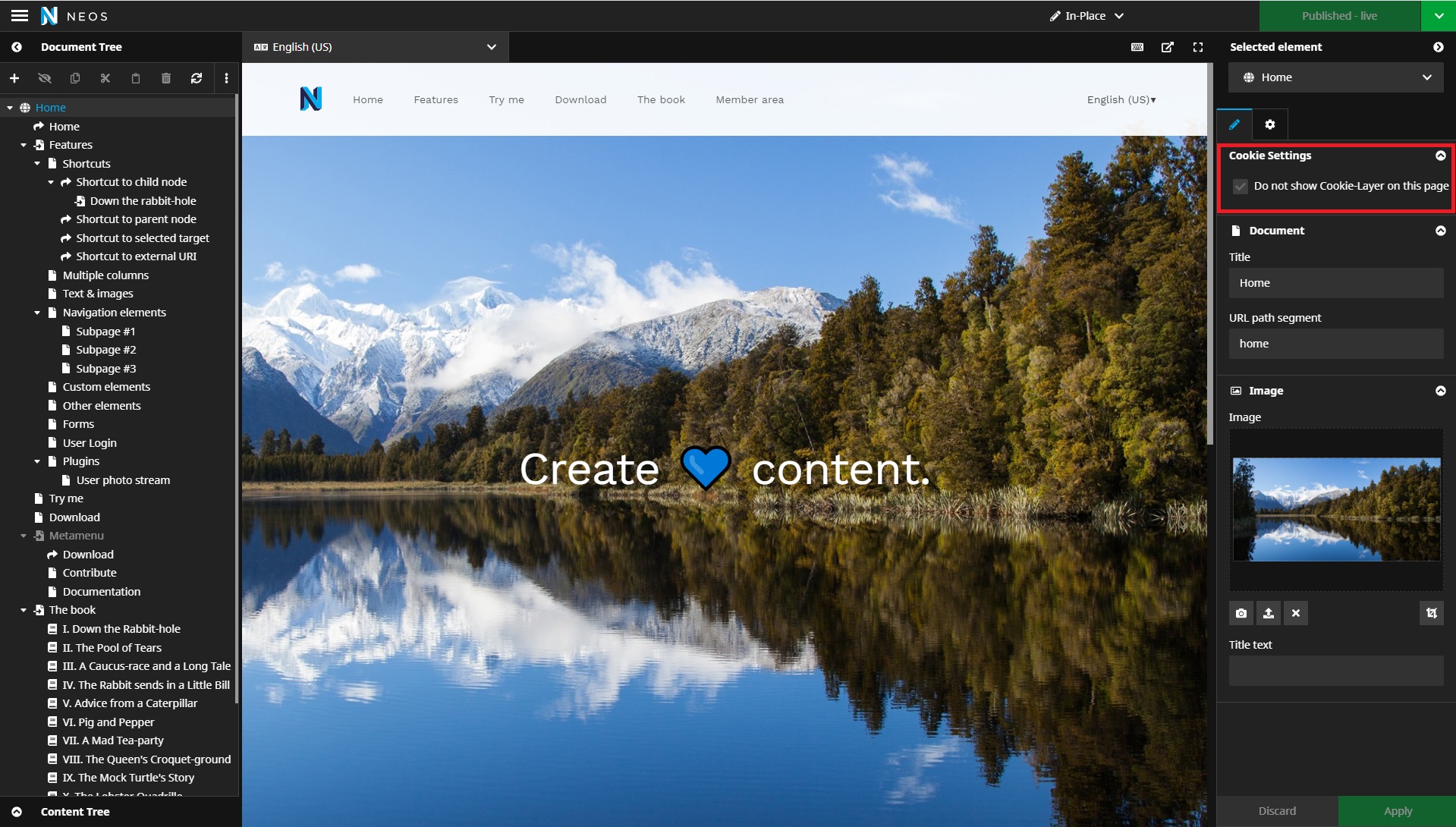# Usage
This package offers PHP and JavaScript functions to safely deal with all your cookies.
# Set up your cookies
This package uses a Settings.yaml to determine which cookies can be added and how to deal with them.
Wysiwyg:
CookieHandling:
cleanUp:
dryrun: false
showCookieDetails: true
consentCookieName: 'cookieConsent' # cookie that stores the settings by a user
cookieGroups:
technical: # key for a specific cookie group
label: 'Technical' # to display group name in the cookie layer
readOnly: true # boolean to determine if a group cannot be disabled by the user
defaultValue: true # boolean to set the default for the cookie group
cookies: # list of all cookies
cookie_a: # key for a specific cookie
cookieName: 'COOKIE_XYZ' # used to save the cookie
lifetime: '2 years' # lifetime of the cookie
cookie_b:
cookieName: 'COOKIE_ZXY'
lifetime: '2 years'
cookie_consent:
cookieName: 'cookieConsent'
lifetime: '3 months'
cookie_accepted:
cookieName: 'cookieConsentAccepted'
lifetime: '3 months'
TIP
Both readOnly and defaultValue are settings for the frontend display in the cookie layer.
The lifetime of a cookie can only be specified in "month(s)" or "year(s)".
The cookies cookieConsent and cookieConsentAccepted are configured by this package; 'cookieConsent' stores a users cookie preferences as JSON, 'cookieConsentAccepted' stores a hash indicating whether a user has accepted the cookie notice yet / the cookie layer should be shown.
# Code changes PHP
All HTTP components you use, that set cookies need to be updated.
You should inject the CookieConsentService
/**
* @Flow\Inject
* @var Wysiwyg\CookieHandling\Domain\Service\CookieConsentService
*/
protected $cookieConsentService;
This service gives you the opportunity to use the function tryAddCookie() that checks if a cookie has been accepted and adds it to the cookie jar.
This function should replace ALL calls to $response->setCookie() or $response->withAddedHeader('Set-Cookie', $cookie).
Instead you will now call $this->tryAddCookie($yourCookie)
Before:
$response->setCookie($cookieToAdd);
OR
$response->withAddedHeader('Set-Cookie', $cookie);
After:
$this->tryAddCookie($cookieToAdd);
# Code changes JavaScript
Before:
$.cookie(cookieName, cookieValue, expire);
JavaScript offers different ways to add cookies, which means your implementation before might look different than this example.
After:
WY.CookieHandling.tryAddCookie(cookieName, cookieValue, expire);
# Dealing with unaccepted cookies
Cookies of your domain that have not been accepted by the user through interacting with the cookie layer will be automatically deleted by the CookieCleanupComponent. This ensures that old cookies from your domain will not remain after a user changes their cookie preferences.
All deleted cookies will be logged to give you the opportunity to track non-configured cookies.
This automatic deletion of cookies can be disabled by flagging the CookieCleanupComponent to use a dry run mode. To enable this add the following to the configuration:
Wysiwyg:
CookieHandling:
cleanUp:
dryrun: true
# CookieLog module
You can easily access the cookie log module via the Neos backend.
 [click to enlarge]
[click to enlarge]
You can see two cookies in this log.
The first one has a 'Configured' info badge. This is a configured cookie to which a user did not consent.
The other one has an 'UNKNOWN' warning badge which indicates that there is no configuration for a cookie by this name.
 [click to enlarge]
[click to enlarge]
# Detection of outdated cookie settings
GDPR requires a new consent for cookies whenever the usage of cookies changes (lifetime changes, new cookies, etc.).
This requirement is covered in this package with cookieConsentVersion, an extra cookie that includes a hash of the current cookie settings you have configured.
Whenever the cookie settings change a new hash is generated and if the generated hash is different to the saved version in the cookie,
the cookie layer will pop up again to force the user to give consent to the new cookie usage.
The new hash is then saved to the cookie.
# Reducing the lifetime of old cookies
Sometimes the need arises to reduce the lifetime of a cookie that users already have saved on their device. In this case the package offers the possibility to add a setting to the affected cookie and reduce the lifetime in the following way.
Add
previousCookieSettingHashwith a random number to the cookie's settings like this:cookie_a: cookieName: 'COOKIE_XYZ' lifetime: '2 years' previousCookieSettingHash: '123'Run the command
./flow cookiehash:forcookie COOKIE_XYZand get the following output:+------------+------------------------------------------+ | CookieName | COOKIE_XYZ | | Hash | 9f087fb91e6e8a9e92460b48abee09f7fc4ab1a7 | +------------+------------------------------------------+or run
./flow cookiehash:cookiehashinformation COOKIE_XYZto see the current hash and more information+------------+------------------------------------------+ | CookieName | COOKIE_XYZ | | Hash | 123 | | BuildHash | 9f087fb91e6e8a9e92460b48abee09f7fc4ab1a7 | | Outdated? | YES | +------------+------------------------------------------+Replace the random number in
previousCookieSettingHashwith the newly generated hashReduce the lifetime in the settings of the cookie
On the next load of the website the cookie layer will pop up again because the configuration has changed and, after saving the cookie settings, the cookies with a lowered lifetime will be updated.
# Pages without cookie layer
According to GDPR some specific pages are not allowed to be blocked by a cookie layer, for example the data privacy page.
In order to comply with the law this package offers a mixin for your documents to block the layer.
Simply add the mixin Wysiwyg.CookieHandling:Mixins.CookieSettings to your document types.
Example:
'My.Site:ContentPage':
superTypes:
'Wysiwyg.CookieHandling:Mixins.CookieSettings': true
In the inspector of these pages you now have the possibility to switch off the cookie layer.
 [click to enlarge]
[click to enlarge]